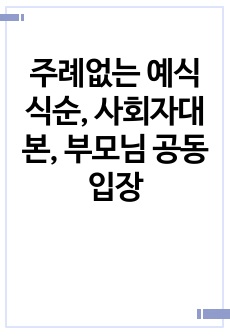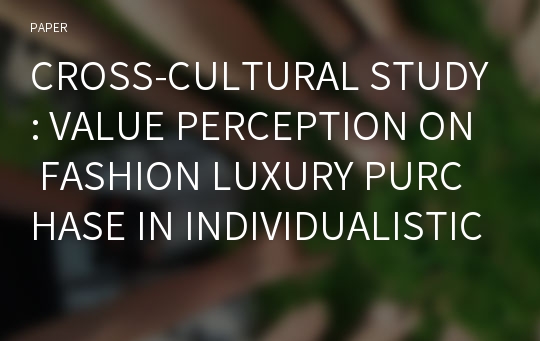CROSS-CULTURAL STUDY: VALUE PERCEPTION ON FASHION LUXURY PURCHASE IN INDIVIDUALISTIC AND COLLECTIVISTIC COUNTRY
* 본 문서는 배포용으로 복사 및 편집이 불가합니다.
서지정보
ㆍ발행기관 : 글로벌지식마케팅경영학회(GFMC)
ㆍ수록지정보 : GFMC Session1
ㆍ저자명 : Raras Cynanthis, Yi Wang
ㆍ저자명 : Raras Cynanthis, Yi Wang
영어 초록
Expensive handbags, in particular, luxury designer handbags are incredibly popular among fashionable women. This is why many fashion houses such as Chanel and Hermes offer handbags as another product line as part of their accessories category (Juggessur, 2011). Some retailers claim that owning a luxury designer handbag worth more than £1,000 can make financial sense to middle-class women, who may not spend as much on clothing, but view an expensive luxury designer handbag as an investment piece which can be used every day, adding a touch of glamour (Juggessur, 2011).The global handbag market encompasses exceedingly dynamic players and an expanding consumer base, which is expected to flourish due to increasing demand from emerging markets and strong performances by the international luxury brands (Digital Luxury Group, 2013). The top 10 markets for luxury handbags, collectively gathered over 120 million online searches, demonstrating substantial global demand for the world’s most covetable luxury items (Digital Luxury Group, 2013) (see Figure 1) .
Figure 1: demand of luxury handbag globally (Digital Luxury Group, 2013)
The country subjects are UK and Indonesia. Despite the fact that both of Indonesia and UK are reflected as positive luxury market (Digital Luxury Group, 2013; Euromonitor, 2014), both of the countries have differences which may lead to different motivation of luxury purchase. Indonesia is emerging market, while UK is a mature market. The rise of emerging market makes difference. Back then, individualist country is more refer to western developed countries, while collectivistic country is refer to eastern developing countries (Hofstede, 2011; Shukla, 2012). Nowadays, emerging countries are catching up with developed countries (Nielsen, 2013).
Increasing exposure to global media and the depiction of western lifestyles in local media seem to have increased the desire for high-quality goods and services among consumers in emerging markets (Belk, 1999). With regards to luxury products and services, studying the consumption patterns in emerging markets is particularly important due to the phenomenal growth of luxury consumption among consumers in these markets (Shukla, 2012). For example, according to Bain and Company (2012), 85 per cent of all luxury stores will be opening in emerging markets over the coming decade. Moreover, recent studies highlight the significantly strong influence of the materialism trait with luxury consumption in emerging markets (Lertwannawit and Mandhachitara, 2011; Podoshen et al., 2011).
As predicted by BCG (2010), in 2015, emerging-market cities will account for around 20 per cent which is $2.6 trillion of the total global consumption of clothing and house as a priority of future expenditures. The key consumer base for luxury goods has long since left Europe, moving West to the United States, but also East to the Gulf States and Asia, and South to Latin America, particularly Brazil (Business of Fashion, 2014). Luxury companies are no longer focusing for mature market. However, luxury goods enable consumers to satisfy their material as well as socio-psychological needs to a greater degree than regular goods (Vigneron and Johnson, 2004; Wiedmann et al., 2009).
Luxury brands are one of the most profitable and fastest-growing brand segments, yet at the same time, the social influences associated with luxury brands are poorly understood and under investigated (Shukla, 2010; Wiedmann et al., 2009; Tynan et al., 2010). Increasing exposure to global media and the depiction of western lifestyles in local media seem to have increased the desire for high-quality goods and services among consumers in emerging markets (Belk, 1999). With regards to luxury products and services, studying the consumption patterns in emerging markets is particularly important due to the phenomenal growth of luxury consumption among consumers in these markets (Shukla, 2012). From those passages, it can be inferred that emerging market countries are the targets of luxury brand companies to invest in the market.
Culture is changing: The rise of Emerging Market
As previously discussed in the second chapter, when the political, societal, and economic environments change, people's cultural values also change. Thus, many cultural theories should be updated and re-evaluated periodically. Hence, Wu (2006) said that Individualistic vs. Collectivistic Dimension theory is no longer applicable. Additionally Saiq et al. (2014) said that Hofstede’s Individualistic Dimension work is too old and can’t be effectively implemented in the era of rapidly changing environment, convergence and globalization. The arguments by Wu (2006) and Saiq et al. (2013) is supporting Bian and Forsythe (2012) which argue that culture is changing as a consequence of the increasingly global economy especially in emerging market, converging in the direction of greater individualism. As a result, collectivist societies might adopt some individualistic elements, but this would not change their societal identity or their social label as a collective society (Bian and Forsythe, 2012).
The contrasts between few contemporary studies of luxury value perception in Individualistic vs. Collectivistic Country (Bian Forsythe; 2012, Li et al, 2012; Shukla and Purani, 2012) (see Table 1) are leading to confusion in understanding value perception on luxury purchase between individualistic country vs. collectivistic country. For an instance, according to Li et al. (2012), a collectivistic country (China) has high consideration of functional value dimension for luxury purchase, but according to Shukla and Purani (2012), a collectivistic country (India) has low consideration of functional value perception for luxury purchase. Another example, according to Bian and Forsythe (2012), an individualistic county (US) consider high personal and social value dimension for luxury purchase, but according to Shukla and Purani (2012), individualistic country (UK) consider low personal and social value dimension on the luxury purchase. The study results were supporting a statement of Shukla (2012) that culture is not static and it keeps changing
Table 1: The contrast between study results about value perception across culture
Impact on the Future Brand Strategy
Consumer value plays as critical role at the heart of all marketing movement and hence undoubtedly deserves attention of every consumer scholars (Holbrook, 1999) especially, in the next decade, customer is predicted as the key orientation of luxury business (BCG Report, 2014) (see Figure 2). The current crisis in luxury marketing area is encouraging companies to look more deeply into the links between consumers and luxury brands (Godey et al., 2013). Consumption of luxury products is based on two main reasons: the purchase for one’s self, for pleasure and purchase as a symbol of success (Godey et al., 2013). Nevertheless, whatever the perspective chosen, the brand remains the main vehicle for connecting with the consumer (Godey et al., 2013).To understand the right brand strategy, the purpose of this study is to identify the constructs of perceived peer communication in social media activities of luxury fashion brands, and to evaluate the influence of those activities on purchase intention in the UK and Indonesia. This research will propose a strategy to enhance brands' performance by defining specific factors relating to purchase intention. Moreover, the findings will enable luxury brands to forecast customer purchasing behaviour. The full conceptual model of this study can be found on Figure 2.
Figure 2: The conceptual model of the study
Methodology
Steenkamp and Baumgartner (1998) suggest using a structural equation modelling approach for cross-culture study. SEM analysis has been successfully applied by many scholars to measure luxury value perception (Bian & Forysthe, 2012; Shukla, 2012; Casidy, 2012; Monkhouse et al., 2013; Hennigs et al., 2013). The structural equation design of this study is illustrated on Figure 3.
The method of self-completion questionnaire allows for a greater geographical coverage than face-to-face interviews without incurring the additional costs of time and travel and they are particularly useful when carrying out research with geographically dispersed populations (Seale, 2012). Self-completed questionnaires were distributed to thirty students with snowball sampling by online survey to each country (UK and Indonesia) and twenty valid samples were utilised from each country. Criterion sampling strategy reviews all cases that meet predetermined criteria (Patton, 2002). Both criterion and snowball sampling techniques were components of a purposeful sampling strategy designed to identify participants with this criteria:
A. Originally from and live in Indonesia or originally from and live in the UK.
B. Having experience in purchasing at least one of luxury handbag.
Figure 3: The structural equation design of the study
Result
There are significant differences of value perception on luxury handbag between Indonesian consumers and UK consumers. Indonesian consumers are highly influenced by Social Value Perception while British consumers are less influenced by Social Value Perception when buying luxury handbags. British luxury handbag consumers are more focusing on the Functional Value Perception which is not much considered by Indonesian consumers. However, consumers from both countries are highly influenced by Personal Value Perception.
참고 자료
없음"GFMC Session1"의 다른 논문
 FAST AND SLOW FASHION BRANDS IN DEVELOPING SUSTAINABLE ..6페이지
FAST AND SLOW FASHION BRANDS IN DEVELOPING SUSTAINABLE ..6페이지 “WHAT IF A CELEBRITY AND A BRAND CO-CREATE A NEW COLLEC..7페이지
“WHAT IF A CELEBRITY AND A BRAND CO-CREATE A NEW COLLEC..7페이지 THE INSTAGRAM’S STRATEGY IN ENGAGING THE CUSTOMER’S LOY..3페이지
THE INSTAGRAM’S STRATEGY IN ENGAGING THE CUSTOMER’S LOY..3페이지 THE PARTICULARITIES OF NEW PRODUCT DEVELOPMENT IN THE T..5페이지
THE PARTICULARITIES OF NEW PRODUCT DEVELOPMENT IN THE T..5페이지 THE LONE CHOCOLATE BAR: THE INFLUENCE OF PERCEIVED SCAR..6페이지
THE LONE CHOCOLATE BAR: THE INFLUENCE OF PERCEIVED SCAR..6페이지 ADS AS WORKS OF ART: MEASURING ADVERTISING IMMERSION3페이지
ADS AS WORKS OF ART: MEASURING ADVERTISING IMMERSION3페이지 ECONOMIES OF SMALL: NICHE STRATEGIES AND SUCCESS FACTOR..8페이지
ECONOMIES OF SMALL: NICHE STRATEGIES AND SUCCESS FACTOR..8페이지 THE INFLUENCE OF ONLINE CUSTOMER REVIEWS ON RETAILERS' ..6페이지
THE INFLUENCE OF ONLINE CUSTOMER REVIEWS ON RETAILERS' ..6페이지 IS THE ARTIFICATION PROCESS PERCEIVED BY FINAL CONSUMER..6페이지
IS THE ARTIFICATION PROCESS PERCEIVED BY FINAL CONSUMER..6페이지 THE ODD EVEN PRICE PARADOX IN THE FASHION LUXURY SECTOR6페이지
THE ODD EVEN PRICE PARADOX IN THE FASHION LUXURY SECTOR6페이지

























